Five Legal Reasons Why Russia’s War is Genocide
In its war against Ukraine, Russia has not only violated international law and committed numerous war crimes, but also committed genocide as defined by the UN Genocide Convention.
Russia’s full-scale invasion of Ukraine demonstrated unprecedented destruction and cruelty. Of course, the attack on Ukraine itself already constituted a breach of international law, particularly the UN Charter. Any destruction of Ukrainian property, and any death of a Ukrainian citizen, including soldiers, already constituted a crime. But in addition to that, the Russian invasion violated a vast number of other laws and treaties. The Russian army shelled residential areas of Ukrainian cities from Lviv in the West to Kharkiv in the East. It has attacked hospitals and schools. Russian soldiers kidnapped, tortured, raped, and executed civilians. The Russian army used incendiary ammunition in residential areas, installed booby traps in civilian buildings, and committed other actions that clearly violated international law and, in many cases, were war crimes.
Still, one of the heaviest accusations against the Russian army is that Russia committed or planned genocide of the Ukrainians. Although often used as a rhetorical term in political discussions, the term “genocide” is very legal. Raphel Lemkin developed it in 1940s as a concept in international law, and its name comes from a combination of the Greek words meaning „a nation“ and „to kill“. Already the name stresses that genocide is a crime aimed at nation-killing, the elimination of a whole nation. The term “genocide” was integrated into international law in 1948. The UN General Assembly approved the Convention on the Prevention and Punishment of the Crime of Genocide[1], or the Genocide Convention, which came into power in 1953 after twenty states ratified it.
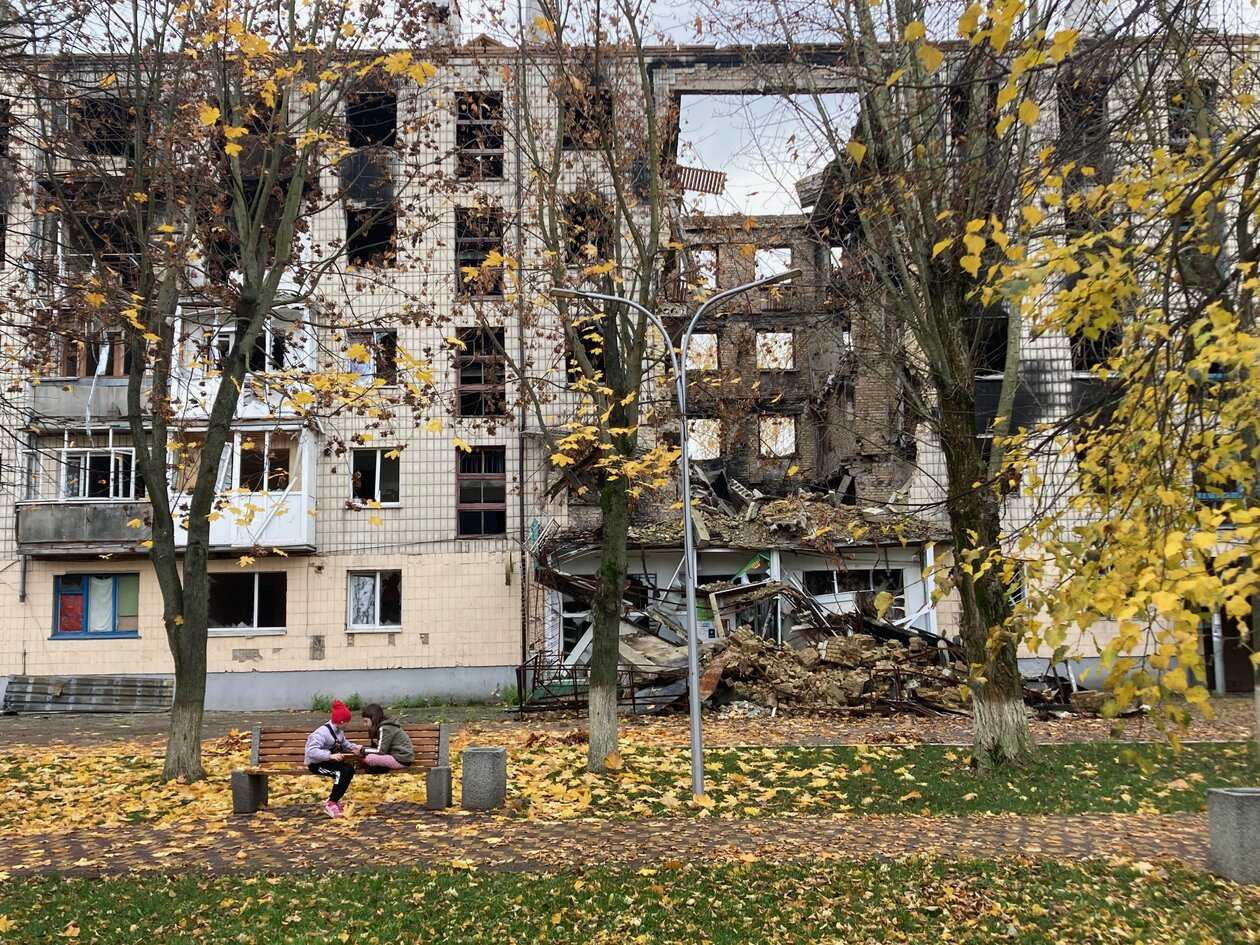
Children play in front of a destroyed multistorey building in Bucha, Ukraine. Sergej Sumlenny, European Resilience Initiative Center
Genocide? Crime against humanity? War crime?
It is to say that, being a severe violation of international law, genocide is not something what international law (or international humanitarian law) seas as an especially severe violation, compared, for example, to crimes against humanity or war crimes. The Genocide convention clearly states that genocide is a crime under international law, is contrary to the spirit and aims of the United Nations, and is condemned by the civilized world (Preamble). Still, as international law does not have a hierarchy of crimes, genocide is not being threatened as a more severe crime than crimes against humanity, although in public opinion, the word “genocide” always sounds like the worst, most terrible crime.
While not staying legally in hierarchic relations, the terms “international crime”, “crime against humanity,” and “war crime” simply deal with different situations and on the basis of different international conventions and other documents.
For example, crimes against humanity (the concept of such crimes has been first fully formulated during the Nuremberg Trial) are extensively described inter alia in Article 7 of the Rome Statute of International Criminal Court,[2] and include murder, rape, enslavement, torture, deportation and other crimes, if “committed as part of a widespread or systematic attack directed against any civilian population, with knowledge of the attack” (Art. 7.1).
Therefore, to constitute the crime against humanity, the named action must be aimed at civil population, be widespread or systematic, and be committed with knowledge of the attack. It is irrelevant if the attack is being committed amid peace, or amid war or an armed conflict. The actions also do not need to be aimed at a certain ethnic or another group. A system of rape in prisons as a tool against political opponents of a dictator, for example, constitutes a crime against humanity.
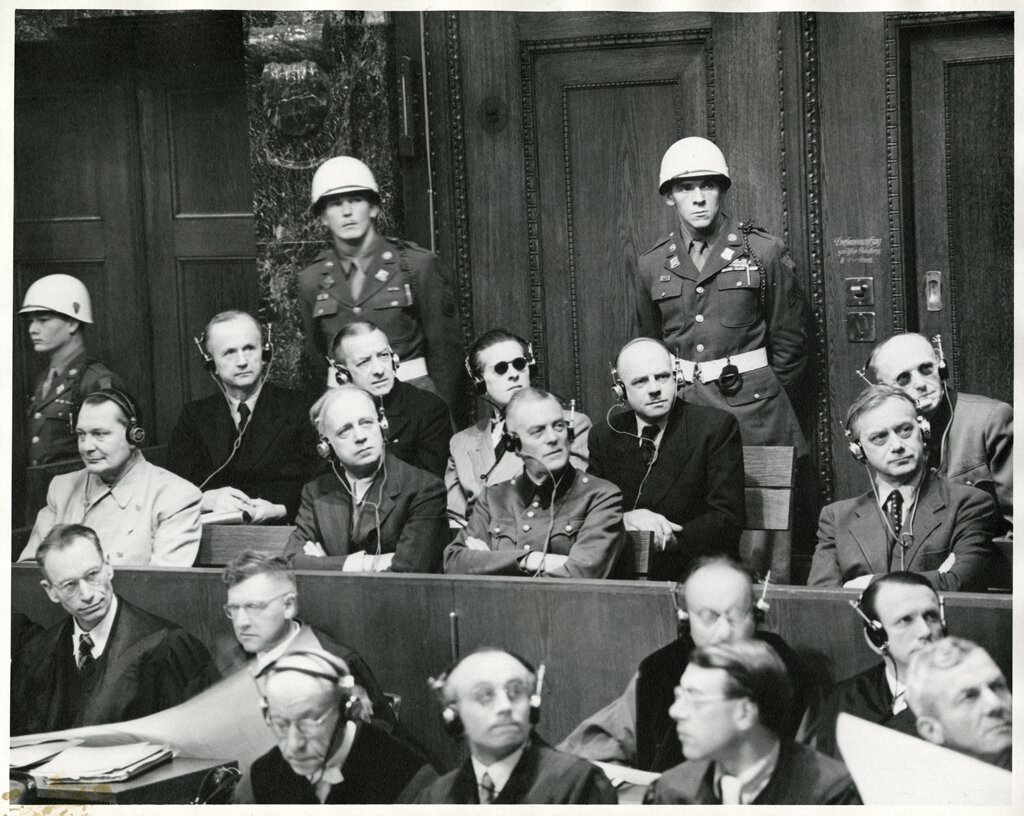
The top Nazis at the Nuremberg Trial, United States Army Signal Corps photographer, Source: Harvard Law School Library, Harvard University
On the contrary, war crimes can happen only during wars and armed conflicts. For example, grave breaches of the Geneva Conventions of 12 August 1949, such as willful killing of persons protected under the provisions of the Conventions (like prisoners of war or medical personnel), or taking of hostages, or attacking of undefended towns or villages which are not military objects, constitute a war crime (Art. 8.2.(a)(i), 8.2.(a)(viii), 8.2.(b)(v) – for the reasons of brevity, we do not link here separate Geneva Conventions, pointing out only Rome Statute of the ICC).
It is to mention that to be named a war crime, an action does not need to be based on the intention to kill or injure, as it is needed in a case of crimes against humanity. For example, a commander who launches an attack on the enemy, accepting the incidental loss of life or injury to civilians, which would be excessive in relation to the direct and concrete military advantage anticipated, commits a war crime (Art. 8.2.(b)(iv)). The same appeals to the usage of certain types of weapons (incendiary ammunition) in the areas where the civilian population is presented. In other words, a war crime can be constituted not only by direct action to illegally harm a person, but also by negligence to the duty to avoid excessive suffering of civilians or to protect religious or cultural objects or even private property.
What defines genocide?
As we see, both crimes against humanity and war crimes are extensive groups of different actions, which have in common either a systematic and grave violation of the human rights of civilians or a violation of the rules of war (which aim to limit the brutality of war). Contrary to this, genocide is a very concrete crime with a very concrete aim.
Article II of the Genocide Convention states genocide means any of the following acts committed with intent to destroy, in whole or in part, national, ethnical, racial, or religious group, as such:
(a) Killing members of the group;
(b) Causing serious bodily or mental harm to members of the group;
(c) Deliberately inflicting on the group conditions of life calculated to bring about its physical destruction in whole or in part;
(d) Imposing measures intended to prevent births within the group;
(e) Forcibly transferring children of the group to another group.
Article I says that genocide can be committed in both peace and war times, and Article III states, that not only genocide itself, but even conspiracy to commit genocide, direct and public incitement to commit genocide, attempt to commit genocide and complicity in genocide are punishable under this Convention. Summarizing, to constitute the genocide crime, the actions must have an intent to destroy a whole or a part of a national, ethnical, racial, or religious group.

Members from the 501st Transportation Squadron, Kaiserslautern Germany, and C Company, 3rd Battalion, 325th Infantry Brigade, Southern European Task Force (SETAF), Vicenza, Italy, and the Task Force 51, Mannheim Germany, bring a convoy of fresh water for Rwandan refugees located at Camp Kimbumba, Zaire. Photographer's Name: TSgt. Marv Krause, VIRIN: J-3003-SPT-94-04-0004-0683
Permission: PD-USGov-Military-Army
This makes genocide a very narrow-shaped specific crime, although of course, genocide can contain elements of both crimes against humanity and/or war crimes. It is also to remember that even a conspiracy to commit genocide or public incitement to commit genocide constitutes a crime. We can see how these aspects can be combined in real life, in the criminal case of Felicien Kabuga, a person behind the Radio of 1000 Hills media in Rwanda, which called for ethnic cleansing against the Tutsis minority. Kabuga was arrested in 2020 in Paris and extradited to the Netherlands in September 2022. He faces trial at International Residual Mechanism for Criminal Tribunals (IRMCT), a UNSC-established tribunal, being charged with three counts of genocide and two counts of crimes against humanity.[3]
Genocide as an emotional accusation?
The Russian invasion of Ukraine was called genocide many times, starting in 2014. Back then, western scholars sarcastically commented on such accusations, ridiculing them as “wild overstatements”. Thomas de Waal from the Carnegie Europe stateed that the Ukrainians were “crying genocide” and “abusing” this word. Repeatedly calling genocide “the deadliest of crimes” and “the ultimate crime”, de Waal provided an impression the Ukrainians overheat the discussion for political reasons – and therefore “fueling a dangerous conflict” with “such fiery rhetoric”.[4] In other words, for de Waal, the Ukrainians who accused the Russians of genocide were at least co-responsible, if not responsible, for the escalating war.
Such skeptical perception of the genocide accusations survived until 2022, and defined the first months of the Russian full-scale invasion. Any discussion of whether Russia was committing genocide automatically received a skeptical reaction. At the same time, whether a nation (or a person) has committed genocide is of pure legal nature and can easily be checked with a legal test.
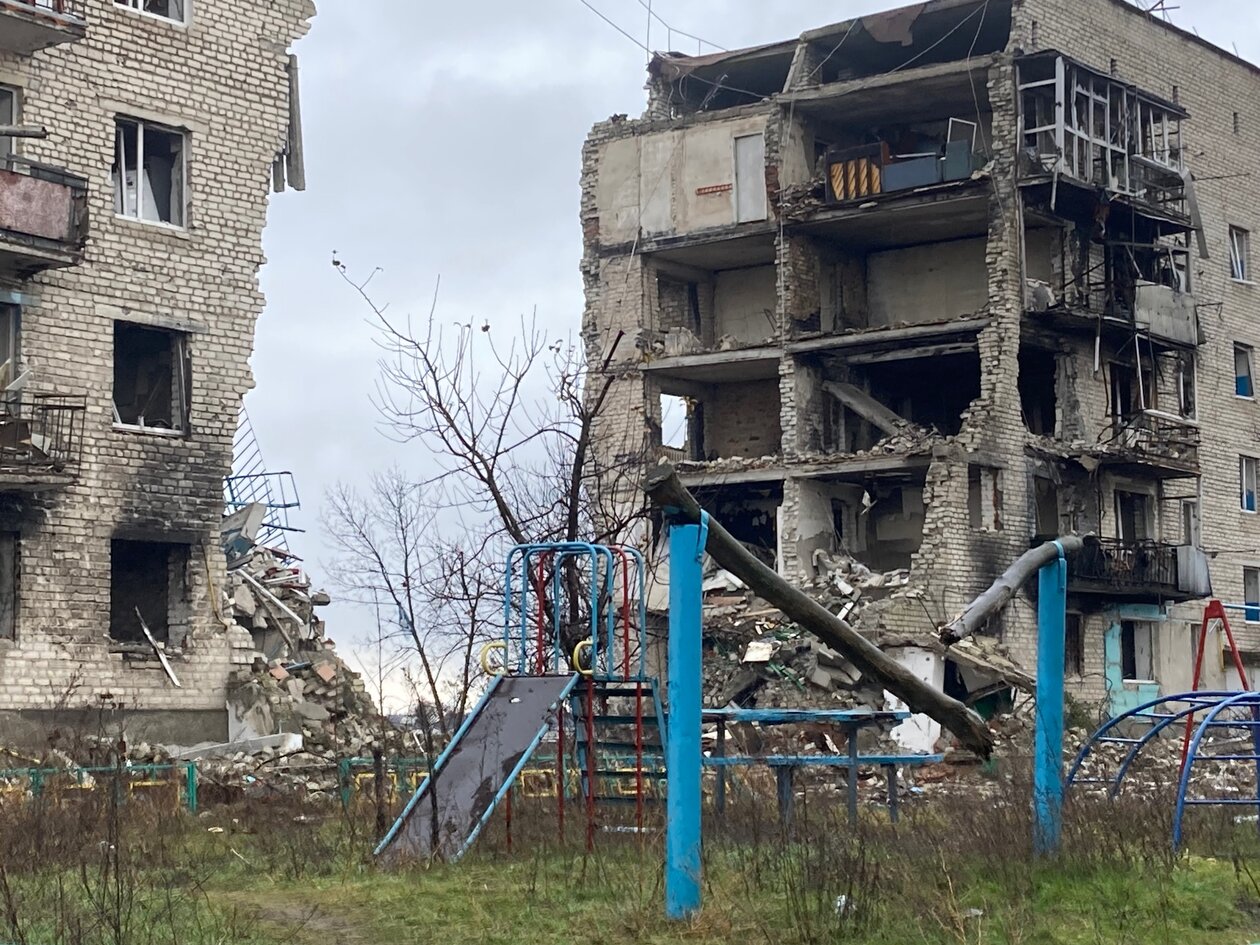
A multistory building in Izyum, destroyed by a Russian strike, Sergej Sumlenny, European Resilience Initiative Center
Did Russia plan genocide?
Before we start with a legal test, let us remember the months before the Russian invasion. In July 2021, Russian president Vladimir Putin published his article “On the historical unity of the Russian and the Ukrainian nations”.[5]He stated that an independent and sovereign Ukraine was an “anti-Russian project” of the West, compared the existence of independent Ukraine with the “use of weapons of mass destruction against Russia”, and said the national self-identification of Ukraine would mean for Russia “a violent and artificial loss of millions of the members of the Russian nation”. This was de facto a denial of any right of Ukrainians to exist. Shortly before the invasion, Putin repeated these ideas in his TV speech, denied the existence of Ukraine and said, Ukraine was a fake, created by Lenin.[6]
On February 26th, shortly after the start of the full-scale invasion, the Russian state-owned agency RIA Novosti, one of the most critical parts of the Russian propaganda machine, published an article, “The Offensive of Russia and the Rise of the New World”. The article, which implied that the war was already won, said that Russia must acquire Ukraine, and this would be “a solution of the Ukrainian question”, which Vladimir Putin decided not to postpone to the next generations. The article was deleted shortly after the publication, probably because the war was not ended yet, but is available via web cache.[7]
Further, in the Autumn 2021, the Russian authority for technical standards developed a technical standard for digging mass graves. The standard foresaw that a team of 16 soldiers should be able to dig a grave for 1,000 bodies within three days and developed rules for preparing and sealing the grave. The standard was valid starting from February 1st 2022.[8] As the standard was openly announced in media, it was speculated that the graves could be needed for the Covid-19 pandemic, although there were no signs of a need for such mass graves. With the Russian invasion of Ukraine, the creation of such standard could be seen from another angle.
Finally, in February 2022, the Russian army purchased, according to Ukrainian authorities, 45,000 body bags.[9] As we know that the original Russian plan was a swift victory over Kyiv within 1 to 3 days, it is unclear for whom these bags were needed, if not for the Ukrainians. One needs to add that the last two facts cannot be seen as genocide evidences per se, as mass killing can be a part of genocide but also of other international crimes. But being caught in a context, they provide us with additional information.
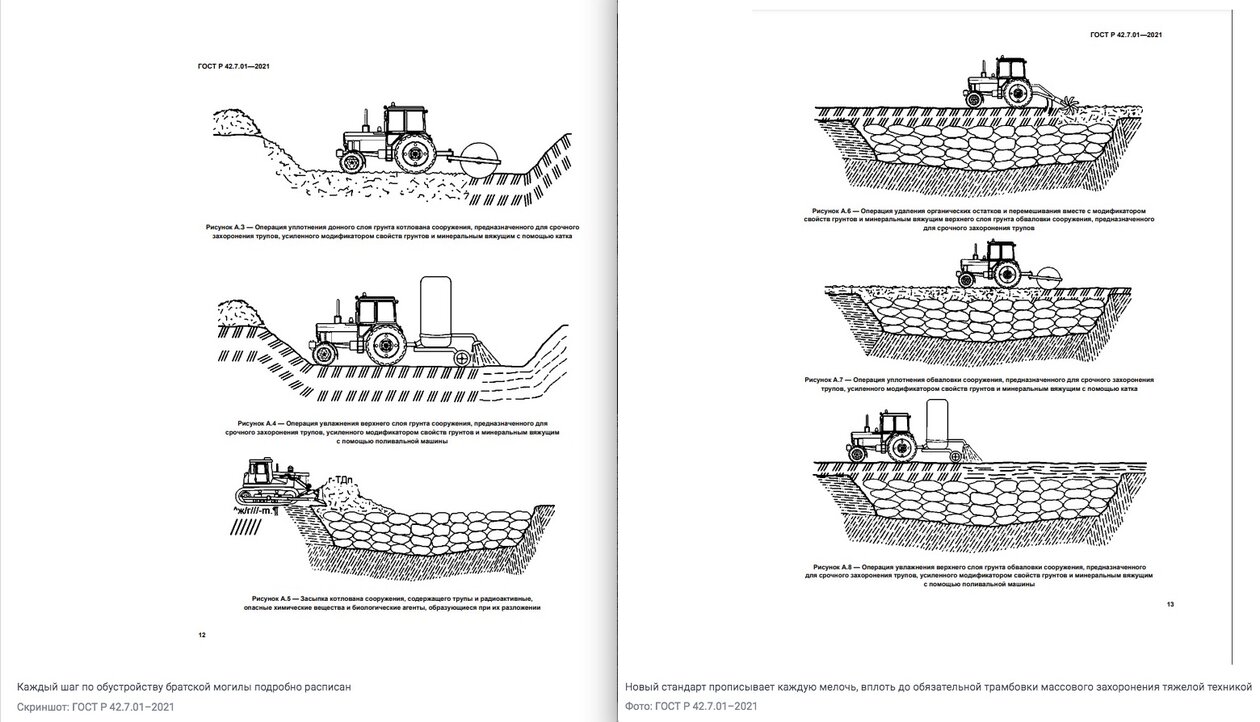
GOST (state technical service) R 42.7.01-2021 for mass graves, screenshot from the web page of the Russian Technical Standards Authority Rosstandart https://docs.cntd.ru/document/1200180859
Did Russia commit genocide?
Let us go through the characteristics of genocide as in the UN Convention. As we remember, Article II states that the genocide crime is fulfilled by any of the actions aimed to destroy a group, in whole or by part, and it is enough even if this action is just planned. In other words, if there was a conspiracy to kill a particular ethnic group, or even a part of it, this conspiracy already constitutes genocide. It is not necessary anymore to wait for the mass murder or to prove that other actions like causing of serious bodily harm etc. were planned. Articles IV, V, and VI also clearly state, that genocide is a crime committed by persons. Therefore it is enough to prove that some persons were involved in a conspiracy or in actions. Of course, these persons can be members of the state institutions and fulfill the state policy, but this is not a necessary condition.
Effectively, we need to check if Russian state policy or the actions of certain groups and persons committed or planned actions described in Article II of the Genocide Convention, analyzing every of the five related ways of how genocide can be committed.
(a) Killing members of the group
On April 3rd, 2022, the Russian state news agency RIA Novosti, a part of the state propaganda holding MIA Rossiya Segodnya, published an article, „What Russia must do with Ukraine“. This article contained clear calls for the mass killing of those Ukrainians who identify themselves with Ukraine. „Denazification will inevitably be deukrainization – the abandoning of the … large artificial pumping of the ethnic component of self-identification of the population of Small Russia and New Russia historical territories”, - stated the author Timofey Sergeitsev. He wrote further: “the Nazis who took arms must me most broadly eliminated on the battlefield. There should be no difference made between the Armed Forces of Ukraine and so called volunteer battalions, and those joined them territorial defence units”.[10] Further, he added that Ukraine’s “leadership should be liquidated, it is impossible to re-educate them”.
On August 28th, Russian officer Igor Mangushev, a leader of a private military company „YENOT“, held a speech in front of his comrades while holding a scull of allegedly Ukrainian solder in his hand. Mangushev said Russia was fighting a war „not against humans from flesh and blood, but against an idea of Ukraine“. He added, „there can be no peace. Ukraine must be deukrainized. ... Everybody who identifies as Ukrainian will be eliminated“.[11] This speech was clearly a development of the ideas from the RIA article. In February 2023, a Russian journalist Anna Dolgareva, said in the studio of „Patriot Mediagroup“: "Denazification means they all (Ukrainians) need to be killed, all adult population of Ukraine who resists - physically destroyed. And their children raised in Russian spirit."[12]
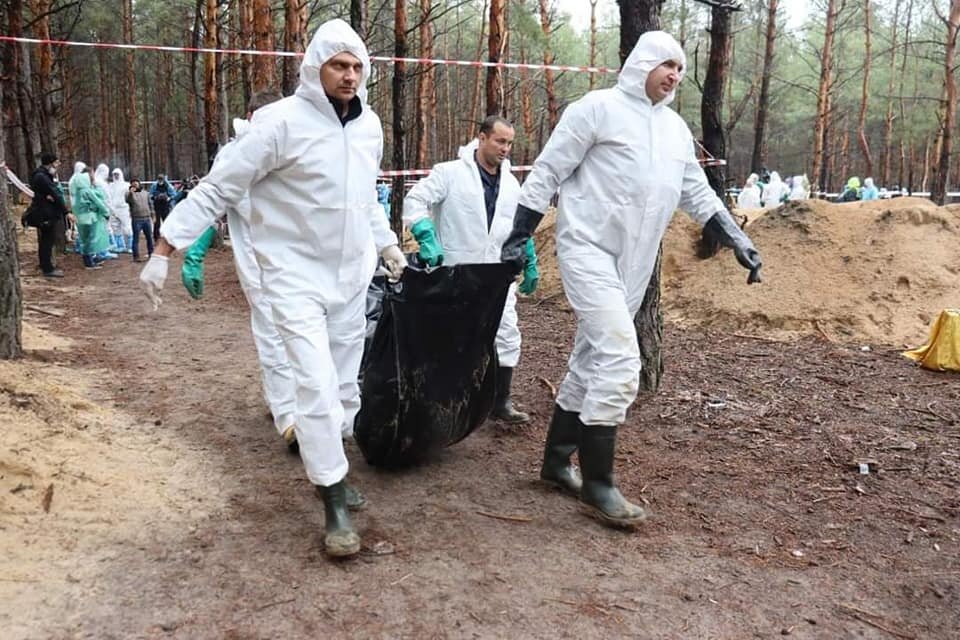
Exhumation of bodies of civilians killed by the Russian army in Izyum, National Police of Ukraine
Those Ukrainians who could be identified as the leaders of the Ukrainian national group were targeted. For example, in Kyiv region, the whole family of a local mayor Olha Suchenko was kidnapped and killed.[13] In Hostomel, Kyiv region, mayor Yuri Prylypko was killed too.[14] This was not a new idea. In 2015, Russian political philosopher Aleksandr Dugin, the leader of the “Eurasian movement”, said in his video interview about Ukrainians: “to kill, to kill, to kill! I say it to you as a professor”.[15] Such ideas found fruitful soil in Russian society. In numerous street interviews, Russian citizens shared their ideas of how Ukraine must be “wiped off the Earth”, “the Nazi-Ukrainians must all be killed”, and “we (the Russians) should take their land”.[16] With these and other numerous examples, we can say, that at least the first criteria of genocide is fulfilled by the Russians, and therefore the case of genocide may be considered as proven. Still, it is important to check other criteria of genocide.
(b) Causing serious bodily or mental harm to members of the group
During the war on Ukraine, the Russian army repeatedly used weapons and tactics which caused excessive harm to the civil population and was aimed on the maximization of the death toll among the population. The Russian army deliberately targeted residential areas. In the city of Kharkiv, with a population of over 1 million inhabitants, over 30% of all residential buildings were damaged or destroyed by bombs and artillery already in April 2022.[17] The Ukrainian civilian population was prevented from escaping the war zone. Civilian cars and busses, clearly marked with the signs of evacuation, were attacked by the Russian army in Luhansk oblast.[18] In Kyiv oblast, cars with women and children escaping the war zone, they were attacked by the Russian troops.[19] Only at the town of Bucha in Kyiv area over 100 cars were found, destroyed by the Russian army, as the vehicles were transporting civilians. This was clear intention to kill civilians.[20]

The aftermath of the Russian invasion on the M06 highway near the village of Myla, in the Bucha district, Stas Kozliuk, CC-BY-SA-3.0
This included the usage of cluster ammunition[21] and incendiary ammunition[22] against residential areas, including such usage in high-density living areas of regional capital cities like Kherson or Kharkiv. Russia also used flachettes-filled artillery shells against the civilian population in Bucha, a town at Kyiv suburb.[23] Flachettes-filled artillery shells spread thousands of tiny arrows, or flachettes, which kill or wound persons. Flachettes are seen as ineffective against military personnel under at least minimum armor protection but effective against unprotected targets like the civilian population. The massive usage of these means and no single known case of prosecution of military commanders for these violations can be seen as a proof that Russia was committing genocide, aiming to maximize the suffering of Ukrainians indiscriminately of their military or civilian status, but based on their membership in the national group.
(c) Deliberately inflicting on the group conditions of life calculated to bring about its physical destruction in whole or in part
Besides the usage of weapons causing excessive harm to civilians, Russia also deliberately attacked the Ukrainian power infrastructure during winter. On Russian TV, the political leaders connected these attacks with the wish to cause the Ukrainians excessive suffering. „They will stay without gas, without electricity, without anything! They must freeze and rot“, - said the deputy speaker of the Russian parliament Boris Chernyshev. He called the missile strike the „holy hate“ strike against Ukraine.[24] On top of the Russian missile strikes against the Ukrainian power grid, about 10 million Ukrainians, or about 25% of the pre-war population, remained without a power supply[25]. One can say that here there is also a sign of a genocidal intention according to Article II (c).
Russia also massively attacked Ukrainian healthcare infrastructure. Ukraine had 1,186 hospitals before the full-scale invasion[26]. According to the health care committee of the Ukrainian parliament, until November 2022, the Russian army has destroyed more than 200 of them, while the overall number of hospitals hit by the Russian military has exceeded 1,000[27]. In other words, the Russians have hit almost every Ukrainian hospital and destroyed 16,9% of them. The total damage of health care infrastructure, including those hospitals located many hundred kilometers behind the front lines, can hardly be interpreted as a side effect of war and most likely should be seen as a deliberate strategy aiming on creating of life conditions for the group causing physical destruction of the group, or the characteristics of the Article II (c).
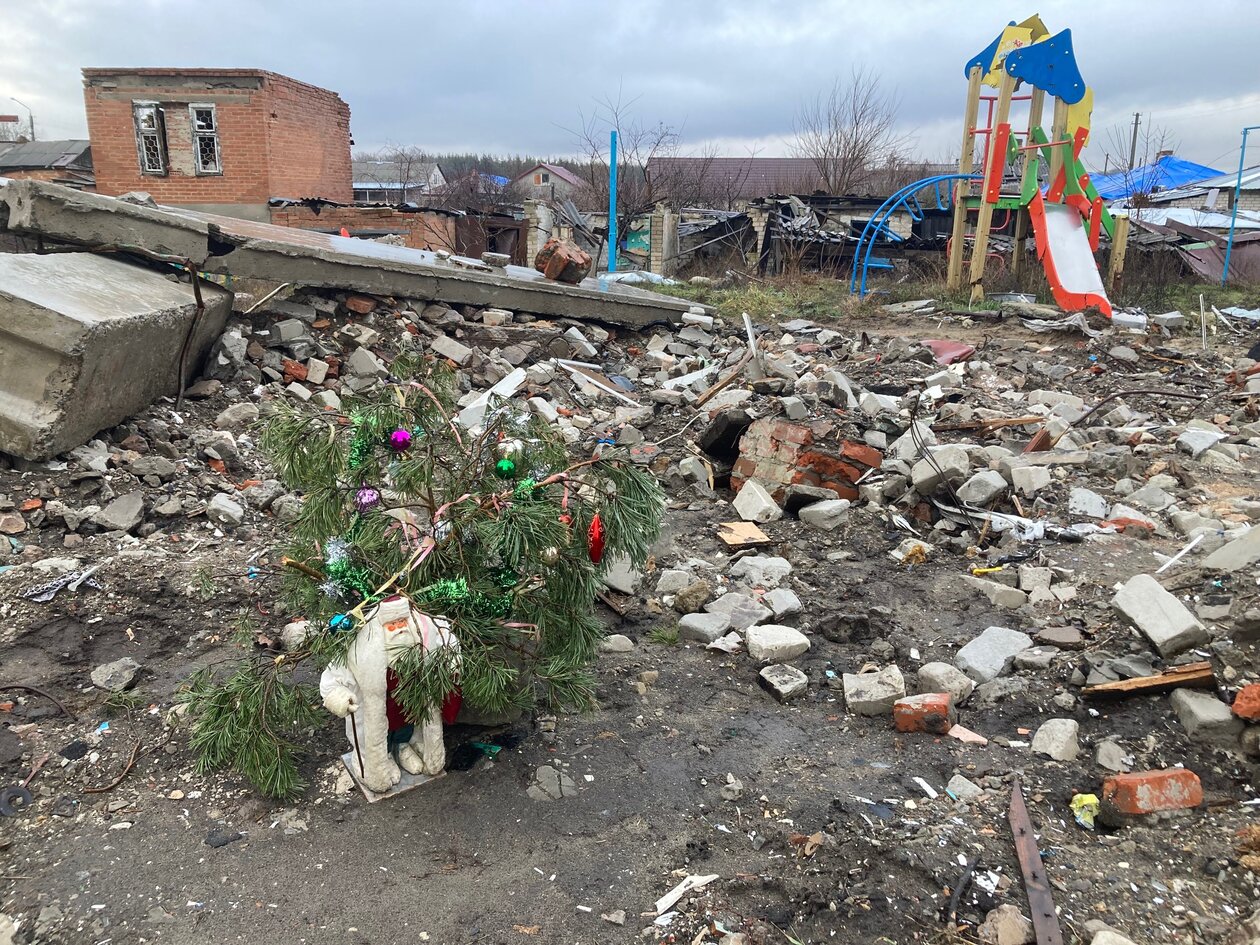
An improvised memorial for civilian victims of a Russian strike, Sergej Sumlenny, European Resilience Initiative Center
Still, the most straightforward cases of genocide were visible in the cases of mass kidnapping, torture, and murder of Ukrainian citizens, who were identified as the most active representatives of the Ukrainian nation. In most liberated cities, the Ukrainian army found mass graves with bodies of dead civilians and torture chambers, which were used to terrorize the Ukrainian population. In liberated Kherson, the Ukrainian military has even found a torture chamber, where exclusively Ukrainian minors have been tortured.[28]
Especially in early the invasion, Ukrainian intelligence tapped numerous phone calls between the Russian soldiers in Ukraine and their relatives back home. In some calls, the soldiers explained in details what system of mass kidnapping and torture was created in occupied towns in order to break the spirit of the Ukrainians. In one of the calls, a soldier told his mother he skinned people alive, broke their bones, beaten them to death, or used other torture methods.[29] In another tapped phone call, a wife of a Russian soldier urged him to kill all Ukrainian kids he could, arguing, “they will grow up and turn into Nazis. … Why does Putin spare them? They all need to be killed”. She also shared her phantasies on how she would torture children: “I would inject them with drugs and say to them, looking into their eyes: you will die, you will suffer. I would cut off their penises, cut off stars on their backs, cut one ear, one finger every day, to cause them pain”, - she said.[30]
Such talks were not just fantasies but a part of reality. In July 2022, a video emerged of a Russian soldier cutting off the genitalia of an alive Ukrainian POW[31]. In September 2022, after the liberation of the town of Izyum, an exhumation of a mass grave, some bodies had signs of torture, including missing genitalia.[32] The level of brutality was clearly connected to the fact of Ukrainian identification of the victims; this can be seen as criminal acts constituting genocide.
(d) Imposing measures intended to prevent births within the group
During the full-scale invasion, the Russian army attacked Ukrainian maternity hospitals several times. The most known attack of that kind was an attack on Mariupol maternity hospital on March 17th, with four people killed and 17 injured, and one child died in stillbirth.[33] This was not the only attack on maternity hospitals. On November 23rd, a Russian air strike hit a small maternity hospital in Vylnyansk, Zaporizhzhia region, killing a newborn.[34] Still, it is hard to say if these attacks can be seen as genocide crimes in the sense of Article II (d) of the Convention. These cases constitute a war crime (attack on protected organizations, in particular hospitals), but it is arguable if Russia had an intention to prevent birth within the Ukrainian nationals group while attacking these hospitals.
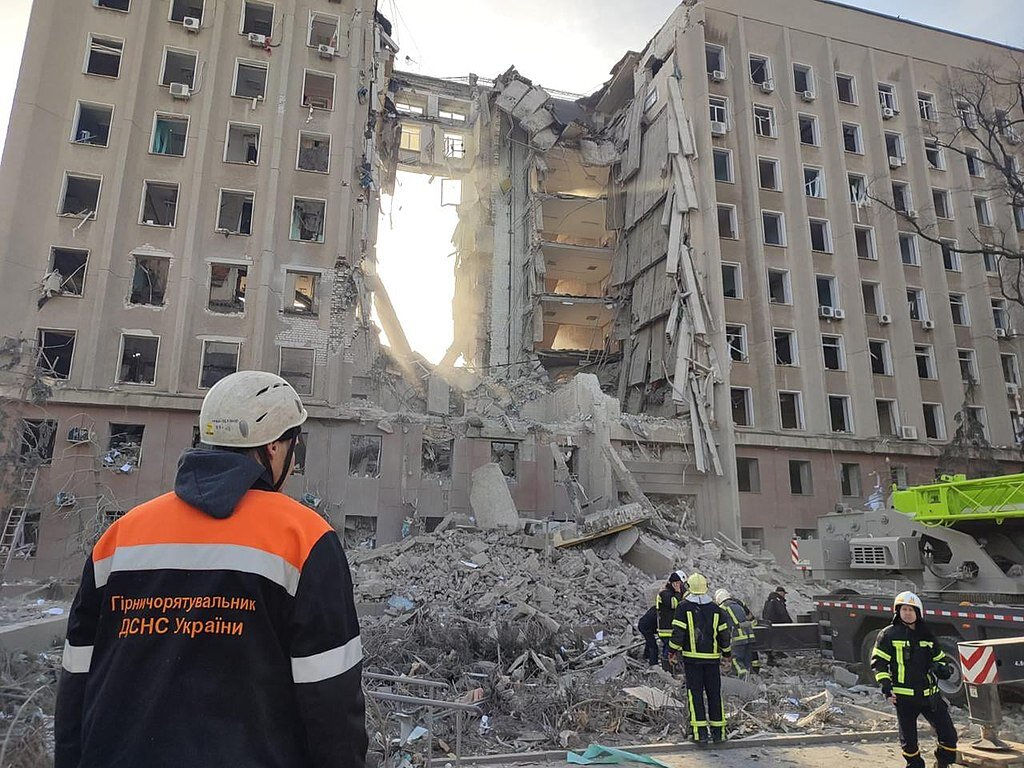
The aftermath of a Russian missile strike on Mykolaiv, State Emergency Service of Ukraine
Another case looks more evident in this context. During the early months of the invasion, the Russian soldiers committed mass rapes in the occupied town of Bucha. According to reports, at least in one case, the Russian soldiers told the victims “they would rape them to the point where they wouldn't want sexual contact with any man, to prevent them from having Ukrainian children."[35] The intensity or sexualized violence was orchestrated by the military command, according to Pramila Patten, the UN special representative on sexual violence in conflict. Ms. Patten said, Viagra has supplied the Russian soldiers to rape Ukrainian women and „dehumanize “ them. She called it a „deliberate tactic“ and part of a „clearly military strategy“.[36] According to report presented by the UN, the Russian soldiers kept Ukrainian women in captivity for weeks, mutilated their genitalia, and raped even four-year-old children.
As we remember, a crime constitutes genocide if there is an intention to destroy wholly or partly a group – also via preventing birth in this group. Looking at the scale of sexualized violence by the Russian soldiers, at their intensity, and their systematical approach, one can assume that at least some of these cases may constitute genocide.
(e) Forcibly transferring children of the group to another group
Forcible transfers of children from one group to another is a typical way to commit genocide. During World War II, Nazi Germany kidnapped tens of thousands of “Aryan”-looking children in Poland and transferred them to German families to “Germanize” them.[37] In Ukraine, the Russian authorities started focusing on transferring children from the very first weeks of the invasion. In April 2022, the Russian ministry of defense officially confirmed the replacement of slightly under 1 million Ukrainians, including 174,000 children.[38] In the same month, the ambassador of Ukraine at the United Nations claimed that Russia had transferred to at least 500,000 Ukrainians, including 121,000 children, to the economically weak regions of Russia. Many of the Ukrainians were transferred to far regions of Siberia and Far East.[39]
The transfer also impacted Ukrainian children brought to Russia without families in order to be adopted there. Already on the 10th of March 2022, just two weeks after the invasion, Vladimir Putin ordered the government to develop legislation for the “easy adoption of Ukrainian children”.[40] Until that moment, the adoption of foreigners was a long and complicated process. In the proposed new legislation, any Ukrainian child was proclaimed a “citizen of LDNR”, and further adopted in Russia without any additional paperwork based on the extra signed “bilateral agreement” between Russia and its puppet “partner republics”.
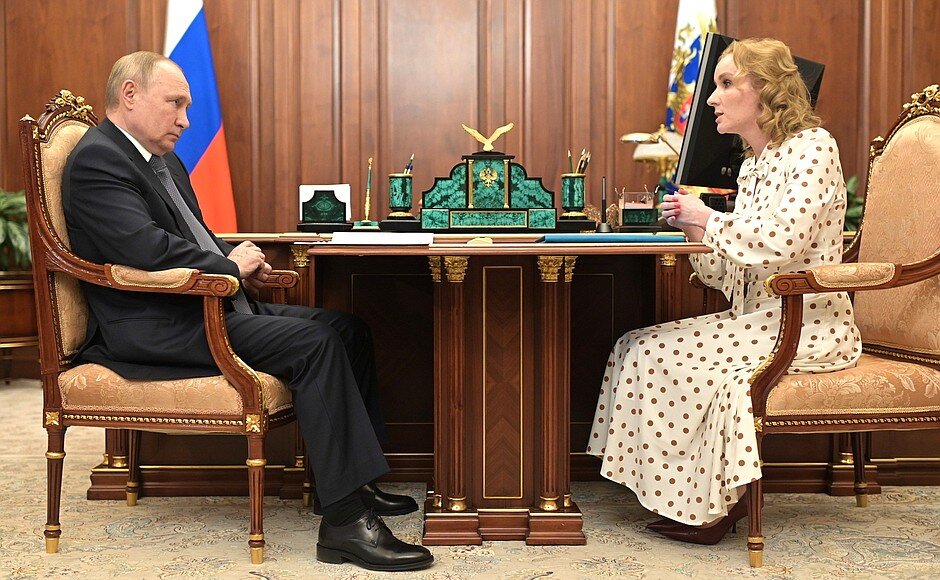
Vladimir Putin and the Russia's children ombudsman Maria Lvova-Belova, Kremlin.ru
The scale of this kind of child transfer is hard to estimate. The Institute for the Study of War claimed that according to different sources, only in 2022 Russia transferred between 6,000 and 150,000 of Ukrainian children.[41] According to Ukrainian National Information Bureau, between February and December 2022, Russia transferred from Ukraine more than 13,000 children.[42] Amid this transfer, the whole children's hospitals were emptied, for example, in the Kherson region. The adoption of transferred Ukrainian children turned into a sort of hype in Russia. Russia’s children’s ombudsman Maria Lvova-Belova proudly told Vladimir Putin, that she adopted a 15-year-old boy from Ukrainian Mariupol. [43]
According to the report of the Yale School of Public Health’s Humanitarian Research Lab (HRL), more than 6,000 Ukrainian children are being held in Russia’s custody. The children in age between four months and 17 years are being sent to re-education in a network of 43 facilities. „Primary purpose of the camps appears to be political re-education. At least 32 (78%) of the camps identified by Yale HRL appear engaged in systematic re-education efforts that expose children from Ukraine to Russia-centric academic, cultural, patriotic, and/or military education. Multiple camps endorsed by the Russian Federation are advertised as “integration programs”, with the apparent goal of integrating children from Ukraine into the Russian government’s vision of national culture, history, and society.”[44] The researchers stated that “all levels of Russia’s government are involved” in the re-education program. Based on the named facts, it seems obvious that the forced transfer of children in order to eliminate the Ukrainian identity is taking place in Russia.
Conclusion
The genocide accusation needs to be proved according to the Genocide Convention of the UN. The Convention says, that genocide is punishable even if was limited to plans, and includes only one of the genocide aspects, and was aimed at a part of a national, ethnic, or religious group.
In the case of the Russian-Ukrainian war, we could state that out of five genocidal actions, at least four took place in Ukraine in multiple cases, and were performed on the level of high-ranked officials. Only regarding the characteristic of genocide according to Article II (d), imposing measures intended to prevent births within the group, it cannot be said, if the reported crimes indeed constitute the crime of genocide or “only” a war crime (Article 8.2.(b)(xxii), or a crime against humanity (Article 7.1.(g)) according to the Rome Statute. This question can be elaborated after more evidence of sexualized violence amid the full-scale Russian invasion of Ukraine is available.
In any case, the other four characteristics of genocide look to be fulfilled by the Russian invaders. Hence, it is possible to say the Russians committed genocide against the Ukrainian nation.
We appreciate your support of our work. Donate and support the European Resilience Initiative Center:
[1] https://www.un.org/en/genocideprevention/documents/atrocity-crimes/Doc.1_Convention%20on%20the%20Prevention%20and%20Punishment%20of%20the%20Crime%20of%20Genocide.pdf
[2] https://www.icc-cpi.int/sites/default/files/RS-Eng.pdf
[3] https://www.voanews.com/a/trial-of-elderly-rwanda-genocide-suspect-opening-at-un-court-/6768249.html
[4] https://carnegieendowment.org/2014/07/28/crying-genocide-use-and-abuse-of-political-rhetoric-in-russia-and-ukraine-pub-56265
[5] http://kremlin.ru/events/president/news/66181
[6] http://kremlin.ru/events/president/news/67828
[7] https://web.archive.org/web/20220226051154/https://ria.ru/20220226/rossiya-1775162336.html
[8] https://docs.cntd.ru/document/1200180859
[9] https://www.dsnews.ua/society/v-sbu-zayavili-chto-rossiyane-zapaslis-45-tysyachami-meshkov-dlya-trupov-23022022-452283
[10] https://ria.ru/20220403/ukraina-1781469605.html
[11] https://theins.ru/news/254476
[12] https://twitter.com/Gerashchenko_en/status/1626266991739666434
[13] https://apostrophe.ua/ua/news/society/accidents/2022-04-03/rossiyskie-natsistyi-ubili-starostu-sela-i-ee-semyu-foto-i-vse-podrobnosti/264769
[14] https://www.dw.com/ru/rossijskie-voennye-ubili-glavu-administracii-gostomelja/a-61038963
[15] https://www.svoboda.org/a/26907371.html
[16] https://www.unian.net/war/rossiyane-rasskazali-chto-na-samom-dele-dumayut-o-voyne-v-ukraine-video-novosti-vtorzheniya-rossii-na-ukrainu-11770369.html
[17] https://www.segodnya.ua/ua/strana/podrobnosti/unichtozhena-tret-terehov-ozvuchil-shokiruyushchie-posledstviya-ataki-na-harkov-1617034.html
[18] https://bigkyiv.com.ua/okupanty-rozstrilyaly-dva-evakuaczijni-avtobusy-z-vodiyamy-vtracheno-zvyazok/
[19] https://novynarnia.com/2022/03/12/rozstrilyaly-kolonu-ditej/
[20] https://tsn.ua/ru/ato/na-mnogih-byla-nadpis-deti-v-buche-obnaruzhili-kladbische-rasstrelyannyh-avtomobiley-foto-2035858.html
[21] https://www.bbc.com/russian/features-61783839
[22] https://hromadske.ua/ru/posts/okkupanty-snova-udarili-po-hersonu-dlya-ataki-ispolzovali-zazhigatelnye-boepripasy
[23] https://www.theguardian.com/world/2022/apr/24/dozens-bucha-civilians-killed-flechettes-metal-darts-russian-artillery
[24] https://www.dialog.ua/war/263164_1669393388
[25] https://www.pravda.com.ua/rus/news/2022/11/15/7376519/
[26] https://ru.slovoidilo.ua/2021/05/25/infografika/obshhestvo/skolko-ukraine-medikov-bolnicz-i-fapov
[27] https://uatv.ua/rossiyane-unichtozhili-v-ukraine-bolee-200-bolnits-bolee-1000-chastichno-povrezhdeny-situatsiya-v-meditsine/
[28] https://www.slovoidilo.ua/2022/12/14/novyna/suspilstvo/deokupovanyx-terytoriyax-vpershe-vyyavyly-kameru-tortur-ditej-ombudsmen
[29] https://www.polskieradio.pl/395/9766/artykul/2952376,russians-torture-ukrainians-until-organs-explode’-report
[30] https://kp.ua/incidents/a649328-audioperekhvat-sbu-zhena-rossijskoho-soldata-prizyvaet-muchit-i-ubivat-ukrainskikh-detej
[31] https://www.theguardian.com/world/2022/jul/29/video-appears-to-show-russian-soldier-castrating-ukrainian-prisoner
[32] https://dumka.media/rus/war/1663748013-v-pogrebenii-v-izyume-nashli-muzhchinu-s-otrezannymi-genitaliyami
[33] https://edition.cnn.com/interactive/2022/03/europe/mariupol-maternity-hospital-attack/index.html
[34] https://trm.md/ru/mezdunarodnye/rusii-au-bombardat-o-maternitate-langa-zaporojie-un-nou-nascut-a-fost-ucis
[35] https://www.bbc.com/news/world-europe-61071243?fbclid=IwAR105Pd2qQLqIZTuIFLGSbNbC2njSGAUUuTf-OimiQk-_2qrMvb43eEuQLQ
[36] https://www.businessinsider.com/russian-soldiers-supplied-with-viagra-to-rape-ukrainians-un-official-2022-10
[37] https://www.dw.com/en/the-children-the-nazis-stole-in-poland-forgotten-victims/a-52739589
[38] https://zn.ua/UKRAINE/minoborony-rf-zajavilo-chto-rossija-deportirovala-uzhe-pochti-million-ukraintsev.html
[39] https://zn.ua/UKRAINE/posle-filtratsionnykh-laherej-ukraintsev-prinuditelno-napravljajut-v-depressivnye-rehiony-rf-kislitsa.html
[40] https://www.mk.ru/social/2022/03/10/v-rossii-rasskazali-o-grazhdanakh-rvushhikhsya-usynovit-detey-donbassa.html
[41] https://www.understandingwar.org/backgrounder/russian-offensive-campaign-assessment-november-16
[42] https://www.currenttime.tv/a/v-hersone-ne-ostalos-detey-ni-v-odnom-detdome-vse-vyvezeny-okkupantami-kak-s-okkupirovannyh-rf-territoriy-propadayut-nesovershennoletnie/32167796.html
[43] https://www.unian.net/war/rf-nezakonno-vyvozyat-detey-iz-ukrainy-rossiyskiy-detskiy-ombudsmen-lvova-belova-usynovila-odnogo-iz-nih-12024948.html
[44] https://hub.conflictobservatory.org/portal/apps/sites/#/home/pages/children-camps-1